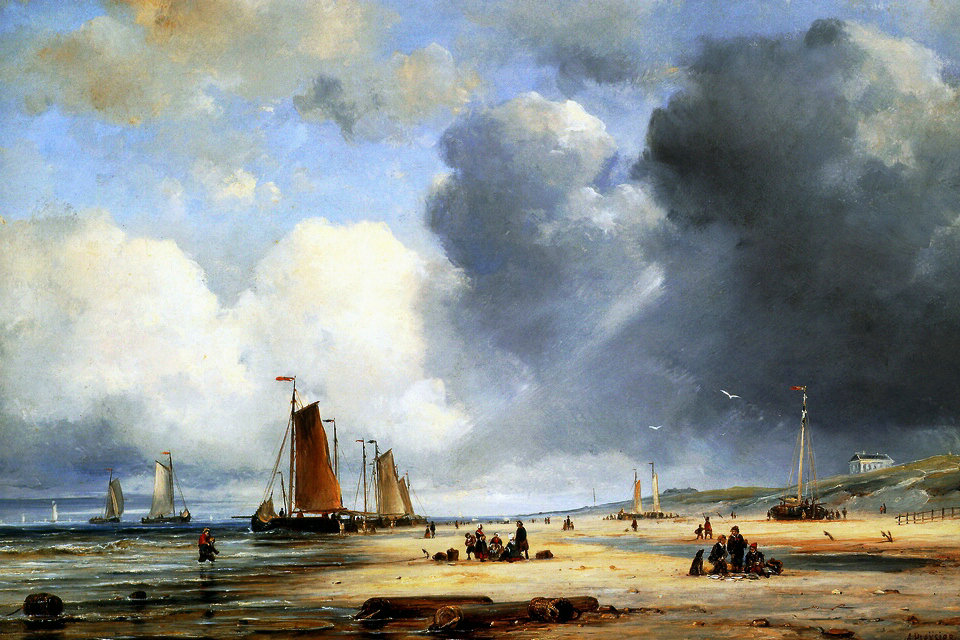

In art, a cloudscape is the depiction of a view of clouds or the sky. Usually, as in the examples seen here, the clouds are depicted as viewed from the earth, often including just enough of a landscape to suggest scale, orientation, weather conditions, and distance (through the application of the technique of aerial perspective). The terms cloudscape and skyscape are sometimes used interchangeably, although a skyscape does not necessarily include a view of clouds.
The sky is part of a so-called trinity plan, which is made up of a distant horizon (mountains, forests). By shifting the horizon to the top of the frame (high horizon), we suppress distant objects and highlight nearby objects and foreground. We avoid, for example, an uninteresting sky without drawing. The horizon location at the bottom of the frame (low horizon) highlights the sky, space and distance. The presence and character of clouds must match and illustrate the mood of the image.
Cloudscape Visual Art
The sky is really nothing more than the denser gaseous zone of the earth’s atmosphere. Sky can be depicted as many different colors, such as a pale blue or the lack of any color at all, such as the night sky, which has the appearance of blackness, albeit with a scattering of stars on a clear night. During the day, the sky is seen as a deep blue due to the sunlight reflected on the air.
The view may be from earth or from a level far above. There is often nothing to suggest scale in the art, unless a bit of landscape is included or some phenomena such as the depiction of clouds, precipitation, rainbows and aurorae. Some artists also depict birds, insects and other flying objects, as well as manmade aircraft, kites and objects such as leaves, and balloons.
A highly complex cloudscape—as in some works of J. M. W. Turner, for example—within an otherwise conventional landscape painting, can sometimes seem like an abstract painting-within-a-painting, nearly obliterating the realistic setting with a grand display of gestural force. Some critics have explicitly cited 19th century cloudscapes and seascapes as precursors of the work of abstract expressionist artists such as Helen Frankenthaler.
Thus, commenting on a 1999 Turner exhibition, New York Times art critic Roberta Smith writes that, in 1966, “the Museum of Modern Art established the artist’s lush late works … as precursors of both Impressionism and modernist abstraction. The current show is a feast of Frankenthaleresque plumes of color….”. Smith further observes that such works “conflate extremes of sea and sky with extremes of painting, showing both to contain elements of the unfathomable and the unknown.”
There are some later cloudscape paintings – for example, the famous cloudscapes of Georgia O’Keeffe – in which the clouds are seen from above, as though viewed from an airplane.
According to an essay at the website of the Metropolitan Museum of Art, “Among the most dramatic and well-known images of O’Keeffe’s later years are her cloudscapes of the 1960s and ’70s. Traveling around the world, she was exhilarated by the views seen from an airplane window.” Below, in the “external links” section, is a link to a color image of O’Keeffe’s gigantic cloudscape entitled “Sky Above Clouds IV” ( 1965; oil on canvas; 8 x 24 ft.; Art Institute of Chicago). Such “airborne-view” cloudscapes are in a sense aerial landscapes, except that typically there is no view of the land at all: only white clouds, suspended in (and even below) blue sky.
Cloudscape Photography
Cloudscape photography is photography of clouds or sky. An early cloudscape photographer, Belgian photographer Léonard Misonne (1870–1943), was noted for his black and white photographs of heavy skies and dark clouds.
In the early to middle 20th century, American photographer Alfred Stieglitz (1864–1946) created a series of photographs of clouds, called “equivalents” (1925–1931). According to an essay on the series at the Phillips Collection website, “A symbolist aesthetic underlies these images, which became increasingly abstract equivalents of his own experiences, thoughts, and emotions”. More recently, photographers such as Ralph Steiner, Robert Davies and Tzeli Hadjidimitriou (see catalogues listed below) have been noted for producing such images.
Some photographers create so-called “skyscrapers” – a database of different types of sky and clouds, from which they are then used to manipulate photographs or photomontage. The author can then add an image with an inappropriate sky from a database image. Known are the interventions of Czech photographer Jan Saudek, who copied dramatic cloud images into his classic black and white photographs (portraits in the landscape, open-window cycle, or familiar wall).
Technique:
In black and white and color photography, polarization filter is used to darken the too bright sky. Because the light reflected from the clouds is not polarized, the polarizing filter does not affect it, resulting in a higher contrast between the clouds and the sky.
Contrast manipulation is commonly used in color filters. For example, the yellow filter darkens the sky, increasing the contrast between the clouds and the clouds (it works to better show the clouds against the blue sky). Red filters have an even more pronounced effect, greatly darken the sky, and improve the rendering of clouds (light areas). When processing photos on a computer, color filter effects can be successfully simulated using the Channel Shuffle function when converting a color photo to black and white.